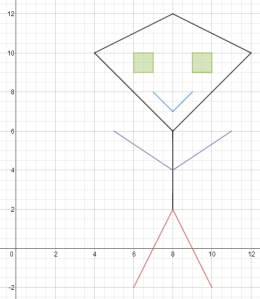Starting next year, the new Swedish course plan will require the inclusion of programming in math classes. I know not all math teachers, especially for younger years, have a lot of experience with this and so I thought I would blog about three good tools.
All the tools I will talk about share two important features:
- They are free to use
- They can be used directly in any web browser
Scratch
- Recommended uses in Sweden: lågstadiet and mellanstadiet
- Available in Swedish and other languages
The first, and probably the most important, is Scratch, a tool developed at MIT and the best introduction to programming out there.
Instead of writing code, students drag and drop ready commands. It is incredibly easy to use and get started with. They recommend a starting age of 8, but younger kids have used it as well (with more guidance). It is also available in Swedish (as well as something like 40 other languages).
Even if it is easy to get start with, Scratch is quite versatile and it is possible to do quit complicated programs.
I recommend moving away from Scratch in högstadiet, since it will be easier to integrate into your math teaching. However, I did want to give a good example of how it is possible to use Scratch even in 9th grade.
The following is an example of a possible assignment. A 9th grade student was asked to create a Scratch project that showed found the equation of a line from two points. This is what he came up with.
Note that this is also an excellent way to assess math skills outside of standard testing. This project required good knowledge of linear equations, basic algebra, fractions, scaling and Euclid’s algorithm for reducing fractions.
However, this would have been much easier using something like JavaScript instead (e.g. using jsFiddle).
Khan Academy Programming Course
- Recommended uses in Sweden: högstadiet and gymnasiet
- English only
Khan Academy has their own online programming course. They have created their own language that seems to be roughly based on JavaScript, but is optimized for graphics.
The advantage here is that they have ready made videos and instructions for students, so even inexperienced teachers can let the students work through the material at their own pace. The focus on graphics and animation tends to make it more fun for students to learn, however it can make some math class applications more annoying to implement. Likely easiest (at least initially) for geometry projects.
A nice feature of their online programming editor is that the code is run as you type it. This gives instant feedback on any changes, which can be helpful for students. Another nice feature is that a teacher can create a sample or template program in the editor and then give a link to it to the students. This can be really nice for specific programming/math projects you want them to work with.
jsFiddle
- Recommended uses in Sweden: högstadiet and gymnasiet
- English only (as much as JavaScript and HTML are based on English)
jsFiddle is an online JavaScript editor. This allows you to create JavaScript programs without needing a website to host them on. Instructions in JavaScript (and basic HTML) will need to come from elsewhere. But this is a great site for trying out programs.
Another nice feature is that, like with Khan Academy, the teacher can create sample or template programs for the students to study or modify.
Once students have some proficiency in JavaScript, this is likely the most versatile for using in math related programming assignments.
Here is a simple example of using the Newton-Raphon method to find the square root of a number.

